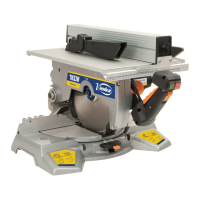12
the machine first, followed by the left-hand side. Once
both parts are fitted on, proceed to join them using
closure clamps D1 (Fig. 6). Then lock the machine in its
transporting position using catch B (Fig. 6), checking that
the cover is perfectly in place and fixed. Release knob A
and lower the handle (Fig. 8). Release knob L, withdraw
the upper aluminium angle which covers the blade
protector and use it as a lateral cutting guide, locking
it again at the required distance from the saw (Fig. 11),
this protector has a side slot that includes two nuts E4
(Fig. 11) designed to lock the wooden fillet that extends
up to the vertical axis of the centre of the saw blade.
Placing this wooden fillet (Fig. 17) is necessary when
making short cuts (dowels or stocks). This is because in
this type of cutting, when the cut piece is ejected from
the centre of the leaf, if it lacks space in coming out, the
turning of the blade, which could cause the accidental
expulsion of the part, will retain it.
The exit position of the saw with respect to the table is
regulated by releasing knobs M (Fig. 1) and placing the
table at the required cutting height, using the height
adjustment knob M2, ensuring that the blade overhangs
the material to be cut only at the level of the tooth,
tighten up the knobs at the selected height.
Lock button E1 in place for cutting with a raised table
(Fig. 8).
Once the cutting work on the table is finished replace
the aluminium angle in the protection position before
using the machine as a mitre saw again.
Do not use the upper table without putting
the lower protecting cover in position.
Never work without the upper protector.
Use push stick E5 supplied with this
machine to feed in the part to the saw
blade (Fig. 21). The machine is equipped
on one of the sides of the upper table
with two fastening supports with which to
attach the E5 thrust rod during transport.
Use the upper protector of the upper
blade correctly.
Ensure that the tilting arm is well se-
cured in position when working on the
upper table.
9. DUST COLLECTION OUTLET
On the rear of this machine there is a Ø 38 mm dust
collection outlet, where it is possible to connect up a
flexible tube, adapting an industrial aspirator or any
system of centralised aspiration for collecting dust and
shavings. We recommend connection to our aspirators
AS182K, AS282K.
For work on the upper table, and in addition to the
connection mentioned above, the fairing is provided with
a nozzle D2 (Fig. 6) to which the standard dust collector
attachment (Ref. 6446073 3.5 m / Ref. 1746245 5 m)
must be connected for perfect collection of the shavings.
We recommend you keep the machine permanently
connected to a dust and shavings collection system.
10. OPTIONAL ACCESSORIES
Ref. 3345416 Set of two pressers (Fig. 20). It is indis-
pensable for cutting aluminium and plastic profiles.
Ref. 3345470 Set of side handles (Fig. 19)
Ref. 7246098 Square for upper table
Ref. 5800100 Movable working table MT58K (Fig. 29)
Ref. 8200100 Aspirator AS182K
Ref. 8200200 Aspirator AS282K
11. MAINTENANCE AND CLEANING
Ensure that the machine is disconnected
from the mains before carrying out any
of these operations.
11.1 CHANGING THE SAW BLADE
Release knobs M (Fig. 1) and raise the table to its maxi-
mum position. Then, press button O and slowly turn the
saw until it is locked (Fig. 1). Next, release screw P (Fig.
12) clockwise using the service key supplied. Once the
saw blade is released move it upwards and then remove
it down through the side of the head of the machine,
avoiding the protector.
Do the reverse of this operation to insert the new saw
blade, positioning the arrow on the blade in the same
direction as that on the tilting protector, checking that
the element seatings are perfectly clean and ensuring
that the external securing disc laser fits perfectly into
the recess at the end of the shaft.
Once the disc has been mounted, move it gently until
the locking button has been released.
- Ensure that the replacement saw blade
has the same diameter than the old one.
- Do not use damaged or deformed saw
blades.
- Select the correct saw blade for the
type of material to be cut.
- Only use the saw blades which comply with
the conditions contained in this manual
and in every case ensure that the body of
the saw blade is thinner than the thickness
of the riving knife and at the same time
the teeth are wider than this thickness.
11.2 CHANGING THE BELTS
To change the belts on the machine proceed as follows:

